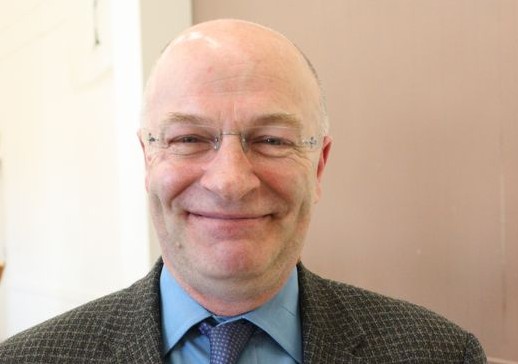October 18, 2011: How can Christians understand and use words of a text, a thing of space and time, to reveal the eternal and transcendent Word of God? How can a doctrine be formed on the basis of the Bible, and how can it be represented visually? These questions are explored in a series of lectures hosted at Canadian Mennonite University (CMU).
CMU welcomes Dr. Peter Widdicombe, Associate Professor at McMaster University in the Department of Religious Studies, as the keynote speaker for the 2011 J.J. Thiessen Lecture series. The theme of his lectures is “Scripture and the Christian Imagination: Text, Doctrine, and Artistic Representation in the Early Church and Beyond.” Widdicombe presents two lectures on October 18 and one on October 19.
Widdicombe’s first lecture earlier today looked at the development of Patristic hermeneutics, focusing more specifically on the thought of Augustine. His second and third lectures explore two examples of how this approach played out in both text and art from the Patristic Period through the Reformation: the account of the Drunkenness of Noah in Genesis 9:20-27, and the reference to foxes and vines in Song of Songs 2:15.
“My research leaves me constantly amazed at the creativity of the Christian writers of the Patristic and Medieval periods,” says Widdicombe. “Theirs was an imagination put to the service of thinking about the world through the eyes of the biblical text in conformity with what that text told them about God as Father, Son, and Holy Spirit. Their sensitivity to the words of the text, the inventive intricacy of their readings and application, and their unstinting dedication to the task of interpretation were extraordinary.”
Widdicombe’s research interests lie in Patristics, the history of doctrine, systematic theology, and artistic representation. His published works focus on Trinitarian and Christological thought and scriptural interpretation in the early church; and on the history of the reception of biblical texts and their artistic representation from the Patristic period through the Reformation.
Widdicombe has his D.Phil. in Patristic Theology, which he received from St. Catherine’s & St. Cross Colleges, at the University of Oxford in 1990. He received his M. Div., Theology from Wycliffe College in Toronto, 1981, his M. Phil., Early Modern History, from St. Catherine’s College in 1977, and his B.A. Hons., in History, from the University of Manitoba in 1974. He has had involvement with organizations like the Canadian Society of Patristic Studies and the North American Society of Patristic Studies. At the Canadian Society of Patristic Studies, he was President from 2000-2002. He has received honours in his membership at the Center of Theological Inquiry in Princeton, 2004-2005, and at the British School of Rome in spring 2010.
Some of Dr. Peter Widdicombe’s recent works include: “Origen,” Blackwell’s Companion to Paul, ed. Stephen Westerholm;“The Gospels of Mark and Matthew in Patristic Interpretation,” Mark and Matthew. Texts and Contexts, ed. Eve-Marie Becker and Anders Runesson. Tübingen: Mohr Siebeck; “The Fatherhood of God in the Writings of Ireneaus,” Irenaeus of Lyons and his Traditions, ed., Paul Foster and Sara Parvis. Minneapolis: Fortress Press ; and Drunkenness, Nakedness, and the Redemption and Fall of an Image: Noah and Christ. Grand Rapids: Eerdmans Publishing Company.
The last of these publications, Drunkenness, Nakedness, and the Redemption and Fall of an Image: Noah and Christ, is the title of the second lecture featured in his three-lecture series.
Widdicombe is presently writing a book on the interpretation of the Drunkenness of Noah in text and art from the early Church through the Reformation. He examines the development of the allegorical approach to the interpretation of Scripture in the Patristic period, the application of that approach in the Middle Ages, and its abandonment at the Reformation. He also observes how changes in the reading of the Drunkenness affect the way in which the incident was portrayed in visually in paintings, sculpture, and manuscript illustrations.
Using visual aids, Widdicombe demonstrates how paintings, sculpture, and manuscript illustrations have been influenced by biblical text and understanding.
Widdicombe fosters discussions and reflection on the Christian faith and its intellectual and cultural expression. He hopes that guests at his lectures take away a greater appreciation for a rich and complex history of biblical interpretation and gain appreciation for how the theological imaginations of earlier periods of the Christian faith can enhance our own.
LECTURE SERIES (CMU Chapel, South Campus, 600 Shaftesbury Blvd. Free Admission)
Oct 18 – 11:00am Words and the Word: Augustine and the Patristic Interpretation of Scripture
Oct 18 – 7:30pm Drunkenness, Nakedness, and the Redemption and Fall of an Image: Noah and Christ
Oct 19 – 11:00am When is a Fox not a Fox? Song of Songs 2:15 and the Need for Vigilance
Text: Evelyn Kampen, CMU Communications & Media Student

